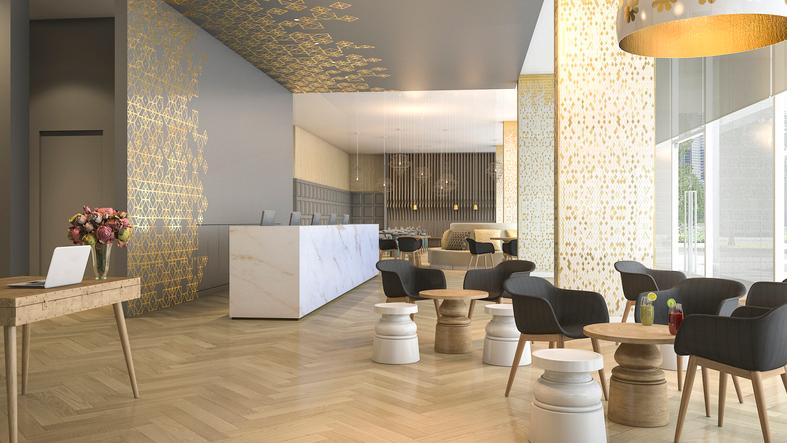Technology is reshaping the hospitality industry, creating immersive experiences for guests. From innovative art installations to augmented reality experiences, and customized lighting sequences, discover how technology is transforming the way we experience hospitality spaces.
Immersive Art Installations: Blending Technology and Architecture
Discover how immersive art installations seamlessly integrate technology and architecture to create unforgettable experiences.
Immersive art installations are revolutionizing the hospitality industry by seamlessly blending technology and architecture. These installations go beyond traditional artwork, transforming venues into immersive experiences that captivate guests. By integrating displays and lighting that seem to be an integral part of the venue's design, these installations can be transformed into vibrant, RGB color displays, enhancing the ambience and mood.
Imagine stepping into a hotel lobby where the walls come alive with dynamic visuals and lighting, responding to the music and creating a mesmerizing sensory journey. These installations not only enhance the aesthetic appeal of the space but also engage and entertain guests, leaving a lasting impression.
With the use of augmented reality (AR) and virtual reality (VR), these installations can incorporate interactive visual elements that attract and engage visitors. Guests can immerse themselves in a virtual world, interact with digital art, and even customize their own experiences. This technology adds a new dimension to hospitality spaces, creating unique and memorable moments for guests.
Customized Lighting Sequences: A Symphony of Senses
Explore how custom software and lighting sequences create a dynamic and unforgettable atmosphere in hospitality venues.
Custom software has become a driving force in the hospitality industry, enabling complex and customized lighting sequences that match the music and setting. Imagine a nightclub where the lighting follows the beat of the music, creating a synchronized sensory experience that enhances the overall atmosphere.
These lighting sequences are not limited to a single color or pattern. With the use of advanced technology, venues can create dynamic lighting effects that change in real-time, responding to the music and creating a captivating visual display. The audio analysis system further elevates the experience by synchronizing the lighting with the sound and beat of the music, creating a truly immersive and unforgettable atmosphere.
By combining custom lighting sequences with interactive elements, such as touch-sensitive panels or motion sensors, guests can actively participate in shaping the ambience of the space. This level of personalization enhances the overall guest experience, making them feel more connected and engaged with the venue.
Augmented Reality Experiences: Bringing Art to Life
Discover how augmented reality (AR) is transforming the hospitality industry by creating interactive and engaging experiences for guests.
Augmented reality (AR) is revolutionizing the way guests experience hospitality spaces. By overlaying digital content onto the physical environment, AR creates interactive and engaging experiences that captivate and entertain guests.
Imagine walking into a restaurant and using your smartphone or AR glasses to see virtual menus, interactive displays, and even virtual characters guiding you through the dining experience. AR can enhance the storytelling aspect of hospitality, immersing guests in a virtual world that complements the physical surroundings.
AR can also be used to provide guests with real-time information and personalized recommendations. For example, in a hotel, guests can use AR to navigate the property, access information about amenities and services, and even receive personalized offers and promotions.
Practical Innovations: Efficiency and Convenience
Explore how technology has facilitated practical aspects of hospitality, improving efficiency and convenience for both guests and businesses.
Technology has revolutionized practical aspects of the hospitality industry, making processes more efficient and convenient for both guests and businesses. Automated check-in systems have streamlined the check-in process, reducing wait times and improving the overall guest experience.
Digital menus have also become increasingly common, allowing guests to easily browse through options, customize their orders, and even place orders directly from their smartphones. This not only improves efficiency for businesses but also provides a seamless and convenient experience for guests.
Large screens and surveillance cameras have found their place in hospitality venues, serving as dynamic canvases for music videos, custom images, or real-time social media feeds. These displays not only attract customers but also contribute to the overall atmosphere and entertainment of the place.
Conclusion
Technology is revolutionizing the hospitality industry, transforming the way guests experience hospitality spaces. Immersive art installations seamlessly blend technology and architecture, creating unforgettable experiences that captivate and engage guests. Customized lighting sequences and augmented reality (AR) experiences further enhance the atmosphere, providing a symphony of senses and bringing art to life. Practical innovations, such as automated check-in systems and digital menus, improve efficiency and convenience for both guests and businesses. Embracing these technological advances is crucial for companies looking to compete and deliver memorable experiences for their patrons.
FQA
How do immersive art installations enhance the guest experience?
Immersive art installations go beyond traditional artwork by seamlessly blending technology and architecture. These installations create captivating and engaging experiences that leave a lasting impression on guests, enhancing the overall guest experience.
What role does augmented reality (AR) play in the hospitality industry?
Augmented reality (AR) is transforming the hospitality industry by creating interactive and engaging experiences for guests. AR overlays digital content onto the physical environment, immersing guests in a virtual world that complements the physical surroundings and enhances storytelling.
How has technology improved efficiency in the hospitality industry?
Technology has facilitated practical aspects of hospitality, improving efficiency and convenience for both guests and businesses. Automated check-in systems and digital menus streamline processes, reducing wait times and providing a seamless and convenient experience for guests.

